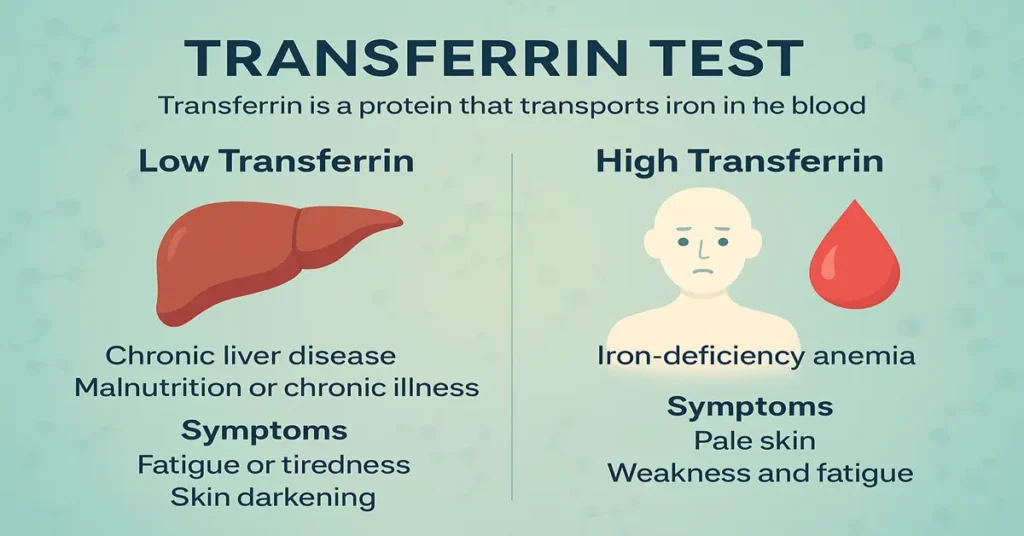Overview
The Transferrin Test is a blood test that measures the amount of transferrin, a protein made by the liver that plays a key role in iron transport throughout the body.
Transferrin acts like a delivery vehicle that binds to iron and carries it through the bloodstream to areas where iron is needed — such as the bone marrow, liver, and muscles.
This test helps doctors evaluate iron deficiency, iron overload, or liver-related conditions, and it’s often performed along with serum iron, ferritin, and TIBC (Total Iron Binding Capacity) tests to get a complete view of your body’s iron status.
What is Transferrin?
Transferrin is the main iron-binding protein in the blood. Its primary job is to transport iron safely to tissues and cells.
Iron is vital for making hemoglobin (which carries oxygen in red blood cells), but free iron can be toxic — so transferrin binds to it, ensuring that it reaches the right places without harming the body.
Where is Transferrin Produced in the Body?
- Transferrin is produced in the liver.
- When iron levels are low, the liver increases the production of transferrin to grab more iron from food and deliver it where needed.
- When iron levels are high, transferrin production decreases, preventing excess iron accumulation in tissues.
This regulation helps maintain the body’s iron balance and prevents both deficiency and overload.
Main Functions and Importance of Transferrin
Transferrin has several key functions that are crucial to healthy iron metabolism:
- Binds to Iron Absorbed from Food
It attaches to iron absorbed in the intestine and keeps it safe during transport. - Transports Iron to Organs
Carries iron to the bone marrow (for red blood cell production), liver (for storage), and muscles. - Maintains Iron Balance
Helps regulate how much iron circulates in the blood and prevents excess buildup. - Prevents Iron Toxicity
Free or unbound iron can cause oxidative stress and tissue damage; transferrin binds to iron to neutralize this risk. - Supports Red Blood Cell Formation
Supplies necessary iron to bone marrow where new blood cells are formed.
In short, transferrin acts like a “taxi service” for iron — picking it up from the gut and dropping it off safely where it’s needed.
Causes of Low Transferrin Levels
Low transferrin levels may indicate problems with the liver, kidneys, or iron overload. It often occurs when the body already has excess iron or cannot make enough transferrin due to illness.
Common Causes:
- Chronic liver disease (damaged liver cells can’t make enough transferrin)
- Kidney disease (protein loss through urine, known as proteinuria)
- Iron overload (hemochromatosis) – body reduces transferrin production when iron is too high
- Malnutrition or low protein intake
- Chronic inflammatory diseases (e.g., rheumatoid arthritis)
- Certain cancers (especially liver or blood-related)
Symptoms of Low Transferrin
(Usually Due to High Iron or Chronic Illness)
- Fatigue or general tiredness
- Joint pain (especially in hemochromatosis)
- Dark or bronze-colored skin
- Abdominal discomfort or pain
- Weakness
- Liver-related issues (enlargement, pain, or jaundice)
Low transferrin often points to iron overload or organ-related illness, so further testing is usually needed.
Causes of High Transferrin Levels
High transferrin levels generally mean the body is trying to absorb and transport more iron, often because there isn’t enough available iron in circulation.
Common Causes:
- Iron deficiency anemia – most common reason
- Blood loss (due to menstruation, injury, ulcers)
- Pregnancy – due to increased iron demand
- Estrogen therapy or oral contraceptive use
Symptoms of High Transferrin
(Usually Due to Iron Deficiency)
- Pale or dull skin
- Fatigue and weakness
- Dizziness or headaches
- Shortness of breath
- Brittle nails or hair loss
- Craving for ice or clay (pica)
- Cold hands and feet
If untreated, this can progress to iron deficiency anemia, affecting oxygen delivery to tissues.
Reference Ranges for Transferrin
| Parameter | Normal Range | Interpretation |
|---|---|---|
| Transferrin | 200 – 360 mg/dL | Normal |
| High Transferrin | >360 mg/dL | Iron deficiency |
| Low Transferrin | <200 mg/dL | Iron overload or liver disease |
Values may vary slightly between laboratories depending on the testing method used.
Sample Type and Test Details
- Sample Type: Serum (blood)
- Tube Used: Red Top (Plain)
- Fasting Required: 8–12 hours recommended (especially if combined with iron studies)
- Associated Tests: Serum Iron, Ferritin, TIBC (Total Iron Binding Capacity), and % Transferrin Saturation
The test involves drawing a small amount of blood from your arm. It’s a simple, routine laboratory test.
Test Preparation
- Avoid iron supplements or multivitamins 24 hours before the test.
- Fast for 8–12 hours if combined with serum iron or TIBC tests.
- Morning sample preferred, as iron levels fluctuate throughout the day.
- Inform your doctor if you are pregnant or taking birth control pills, as they can affect transferrin levels.
When to Consult a Doctor
You should consult your doctor if you notice:
- Constant fatigue or weakness
- Pale or bronze-colored skin
- Irregular heartbeat
- Abdominal or joint pain
- Symptoms of anemia or liver dysfunction
Abnormal transferrin levels often point to underlying health conditions such as liver disease, anemia, or iron overload — all of which require proper diagnosis and treatment.
Important Word Explanations
| Term | Meaning |
|---|---|
| Transferrin | A liver-made protein that binds to iron and transports it in the blood. |
| Iron Deficiency Anemia | A condition caused by lack of iron, leading to low hemoglobin and fatigue. |
| Hemochromatosis | A genetic condition causing excess iron absorption. |
| Ferritin | A protein that stores iron in the liver and tissues. |
| Pica | Craving for non-food items like ice or clay, common in iron deficiency. |
| Serum | The liquid portion of blood after clotting, used for testing. |
~END~

